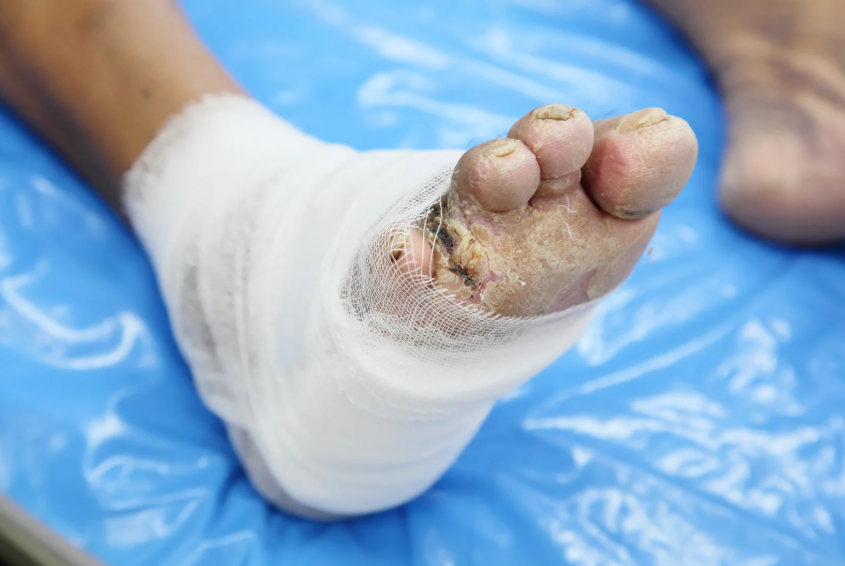Diabetic foot disease is a severe complication of diabetes that affects millions of individuals worldwide. Without proper medical care, this condition can lead to infections, ulcers, and even amputations. Orthopedic treatment for diabetic foot disease plays a critical role in preventing complications and promoting faster recovery. By addressing foot deformities, pressure distribution, and mobility issues, orthopedic specialists help diabetic patients maintain their quality of life while minimizing long-term risks.
Understanding Diabetic Foot Disease
Diabetic foot disease arises due to prolonged high blood sugar levels that damage nerves and blood vessels, leading to poor circulation and loss of sensation. This makes individuals more susceptible to injuries and infections. Symptoms include swelling, redness, sores, and a diminished ability to feel pain or temperature changes. Early detection is crucial, as delayed treatment can lead to serious complications. Orthopedic treatment for diabetic foot disease helps manage these symptoms by providing specialized footwear, support braces, and corrective procedures to prevent further damage.
Role of Orthopedic Treatment in Managing Diabetic Foot Disease
Seeking orthopedic treatment for diabetic foot disease can significantly improve foot health by offering solutions tailored to the patient’s needs. Orthopedic specialists focus on:
- Custom orthopedic footwear and insoles – Designed to relieve pressure on vulnerable areas, reducing the risk of ulcers and calluses.
- Braces and supports – Help in maintaining proper foot alignment and reducing strain on affected areas.
- Surgical interventions – In severe cases, corrective surgery may be required to remove infected tissue or fix foot deformities.
- Gait analysis and biomechanical assessments – Ensure that walking patterns do not contribute to additional foot damage.
Through these strategies, orthopedic treatment for diabetic foot disease not only manages symptoms but also prevents irreversible complications.
How Orthopedic Treatment Prevents Complications
One of the primary benefits of orthopedic treatment for diabetic foot disease is its ability to prevent serious complications. Some of the ways orthopedic care achieves this include:
- Reducing ulcer formation: Pressure redistribution through specialized footwear and orthotic devices prevents excessive stress on certain areas of the foot, reducing the likelihood of ulcer formation.
- Preventing infections: Wounds and ulcers that go untreated can become infected, potentially leading to gangrene and amputation. Proper foot care, supported by orthopedic interventions, lowers this risk.
- Correcting foot deformities: Conditions such as Charcot foot, claw toes, and bunions are common in diabetic patients. Orthopedic specialists provide treatments that correct these deformities before they lead to further complications.
- Improving circulation: Bracing and custom insoles help with proper weight distribution, allowing better blood flow to the feet and promoting healing.
Enhancing Recovery with Orthopedic Care
Recovery from diabetic foot disease is a long process, requiring continuous care and attention. Orthopedic treatment for diabetic foot disease plays a crucial role in ensuring that patients recover effectively while preventing future complications. The recovery process includes:
- Orthopedic rehabilitation – Exercises and therapies designed to restore strength and mobility.
- Wound care management – Proper dressing and offloading techniques to ensure wounds heal without complications.
- Regular foot assessments – Scheduled check-ups to monitor progress and adjust treatment plans.
- Education on foot care – Patients are taught how to maintain foot hygiene, inspect their feet for signs of trouble, and make necessary lifestyle changes.
With orthopedic treatment for diabetic foot disease, patients experience faster healing, fewer complications, and an improved quality of life.
Choosing the Right Orthopedic Specialist for Diabetic Foot Care
Selecting the right specialist is essential for effective orthopedic treatment for diabetic foot disease. Here are some key factors to consider:
- Experience and qualifications – Ensure the specialist has expertise in treating diabetic foot conditions.
- Comprehensive treatment plans – A good orthopedic doctor should offer a combination of non-surgical and surgical options tailored to individual needs.
- Multidisciplinary approach – Working with podiatrists, endocrinologists, and wound care specialists ensures holistic management of the disease.
- Patient reviews and recommendations – Looking at testimonials and consulting with other diabetic patients can help find a trusted specialist.
By choosing a qualified expert, individuals can receive effective orthopedic treatment for diabetic foot disease, minimizing complications and enhancing overall foot health.
Takeaway
Managing diabetic foot disease requires a proactive approach, and orthopedic treatment for diabetic foot disease provides essential solutions to prevent complications and enhance recovery. By using custom footwear, braces, surgical interventions, and rehabilitation strategies, orthopedic specialists help diabetic patients maintain mobility, prevent infections, and improve their overall well-being. Seeking early intervention and maintaining regular foot care routines are key to preventing long-term damage. If you or a loved one is at risk, consulting with an orthopedic specialist today can make a significant difference in preserving foot health and quality of life.






